Abstract
In the “dual carbon” objective, the preparation of non-precious metal catalysts with low cost and high activity is essential for the study of hydrogen evolution reactions (HERs). This study employed biomass pomelo peel powder as the carbon source and ammonium metatungstate (AMT) as the tungsten source and, through a facile one-step method in molten salt, fabricated a biomass carbon-based nanocatalyst featuring carbon flakes adorned with tungsten carbide (WC) nanoparticles. Dicyandiamide and cysteine were introduced as nitrogen and sulfur sources, respectively, to explore the impacts of N-S elemental doping on the structure, composition, and HER performance of the WC/C catalyst. The experimental results showed that N-S doping changed the electronic structure of WC and increased the electrochemically active surface area, resulting in a significant increase in the HER activity of WC/C@N-S catalysts. The WC/C@N-S catalyst was evaluated with hydrogen evolution performance in a 0.5 mol/L H2SO4 solution. When the cathodic current density reached 10 mA/cm2, the overpotential was 158 mV, and the Tafel slope was 68 mV/dec, underscoring its excellent HER performance. The outcomes offer novel insights into the high-value utilization of agricultural biomass resources, and pave the way for the development of cost-effective, innovative hydrogen evolution catalysts.
1. Introduction
In a critical period of the global energy landscape transitioning to green sustainability, hydrogen energy has become a core component of the future energy system by virtue of its unique advantages of cleanliness, high efficiency, high energy density, and the combustion product of water only [1]. As a key step in the acquisition of hydrogen energy, the efficiency of hydrogen evolution reactions (HERs) directly determines the cost of hydrogen production and the feasibility of large-scale hydrogen energy application [2]. Therefore, the development of efficient and low-cost hydrogen precipitation catalysts is the current research focus and hotspot in the energy field [3].
Carbon-based nanomaterials from biomass have emerged in the field of catalysts due to their wide range of sources (e.g., agricultural and forestry wastes, animal manure), low cost, green preparation process, as well as unique nanostructures and rich surface functional groups [4,5,6]. These materials can not only effectively utilize waste biomass resources and reduce environmental pollution but also possess good electrical conductivity, chemical stability, and large specific surface area, which provide an ideal carrier and active site basis for hydrogen precipitation catalytic reactions [7]. However, the hydrogen precipitation catalytic activity of the original biomass carbon-based nanomaterials often makes it difficult to meet the demands of practical applications [8,9].
Tungsten carbide (WC) has attracted much attention due to its high catalytic activity, good stability, and low cost [10]. The catalytic activity of WC originates from its unique electronic structure, and its surface has electronic properties similar to those of platinum (Pt), which is able to adsorb hydrogen atoms effectively and promote the generation of hydrogen gas. In addition, the catalytic performance of WC is closely related to its crystal structure (e.g., hexagonal or cubic crystal system) and surface morphology. Elemental doping, as an effective strategy to optimize material properties, shows great potential in enhancing the performance of catalysts [11,12]. Many scholars have shown that by introducing specific heteroatoms, such as nitrogen (N) [13,14,15], phosphorus (P) [16], and sulfur (S) [17,18], into biomass carbon-based nanomaterials, it is possible to significantly change the electronic structure, charge distribution, and surface chemistry of the materials. This micro-level modulation can create more active sites and enhance the adsorption and desorption of hydrogen evolution reaction intermediates, which in turn improves the hydrogen evolution reaction activity and stability of the catalysts [19,20].
Although some progress has been made in the study of the effect of elemental doping on the hydrogen precipitation performance of carbon-based nanocatalysts for biomass, there are still many urgent problems to be solved. For example, the optimal doping concentration and doping mode of different elements are still unclear, the interaction mechanism between dopant elements and carbon matrix is not yet fully understood, and how to maintain the long-term stability of catalysts under complex practical reaction conditions is yet to be determined. An in-depth study of these issues is of crucial importance for further optimizing catalyst design and developing high-performance, low-cost, and sustainable carbon-based nanohydrogen precipitation catalysts for biomass.
The aim of this study is to systematically illustrate the effects of N and S elemental doping on the hydrogen precipitation performance of biomass carbon-based WC/C nano-catalysts, and to reveal the intrinsic law of WC/C catalytic activity by combing and analyzing the results of this study, so as to provide a theoretical basis and technical support for the development of high-performance biomass carbon-based nanocatalysts for hydrogen precipitation.
2. Materials and Methods
2.1. Preparation of Materials
Pomelo peel was dried and ground into powder. The required amounts of pomelo peel powder, NaCl, and KCl were weighed with an electronic balance, and the weighed raw materials were ground in a ball mill at a frequency of 1200 r/min for 10 min to mix them fully, wherein the ball material mass ratio was set to 3:1; the diameter of the grinding ball was 5 mm; the mass of the pomelo peel powder was 1 g; the mass of NaCl and KCl was 10.99 g and 14.02 g, respectively; and the molar ratio of NaCl and KCl was 1:1. The mixed raw materials were put into an alumina ceramic crucible and placed in a high-temperature chamber furnace. The air in the chamber furnace was extracted by a vacuum pump, 0.1 L/min of N2 was passed in, and then the high-temperature chamber furnace was electrically heated with the temperature set at 900 °C for 1 h to produce biomass carbon (denoted as C). Then, N-doped and N-S-doped biomass carbon, denoted as C@N and C@N-S, were made by adding dicyandiamide with a mass of 2.25 g and different contents of cysteine, respectively.
WC/C, WC/C@N, and WC/C@N-S catalysts were prepared by adding different masses of amine metatungstate (AMT) feedstocks on the basis of C carriers with the same operation in a high-temperature chamber furnace. In order to investigate the effect of different C content and S content on the catalyst performance, the experiments were designed with the addition of pomelo peel powder with masses of 0.5, 0.75, 1, 1.25, and 1.5 g, and cysteine with masses of 0, 0.25, 0.5, and 0.75 g. The specifications of the reagents used in the experiments are shown in Table 1. Compositional design of experimental materials is shown in Table 2.

Table 1.
Used chemicals.

Table 2.
Compositional design of experimental materials.
2.2. Characterization of Material Morphology and Structure
The prepared tungsten carbide as well as the composite materials of tungsten carbide were determined by X-ray diffraction (XRD, D8-ADVANCE-A25, Bruker Corporation, Berlin, Germany). The test instrument used a Cu target, a Kα-ray source, an operating voltage of 40 kV, a current of 40 mA, and a scanning angle (2θ) of 10° to 80°. A Nano SEM450 scanning electron microscope (SEM, FEI Company, Hillsboro, OR, USA) and a TALOS F200X transmission electron microscope (TEM, Thermo Fisher Scientific, Waltham, MA, USA) were used to examine the surface profile, micro-morphology, and crystal structure information of the samples. X-ray photoelectron spectroscopy (XPS, AXIS UltraDLD, Shimadzu Corporation, Kyoto, Japan ) analysis provides information about the molecular structure, chemical bonding, and chemical state of the compounds.
2.3. Electrode Preparation and Electrochemical Testing
A 5 mg sample of catalyst powder was added to 0.5 mL of ethanol, 0.5 mL of deionized water, and 20 μL of 5% Nafion solution to form a homogeneous mixture by sonication for 60 min. A 10 μL quantity of the mixture was transferred to the glassy carbon electrode (area of 0.07 cm2) via a microsyringe, dried at room temperature, and a uniform catalyst-covered film was formed on the electrode surface (loading capacity of 0.71 mg/cm2). The electrocatalytic hydrogen precipitation performance was analyzed using a three-electrode setup, in which the working electrode glass was the glazed carbon electrode, the reference electrode was the saturated calomel electrode (immersed in 3.5 mol/L potassium chloride solution), and the counter electrode was the graphite electrode. Nafion used was purchased from Aladdin (Shanghai, China), and all other agents were purchased from Sinopharm Chemical Reagent Co., Ltd. (Shanghai, China). The samples were then tested for electrochemical properties using a CHI660D electrochemical workstation (Shanghai, China).
3. Results and Analysis
3.1. Physical Phase and Morphology Analysis of Biomass Carbon Carriers
The XRD analysis patterns of biomass carbon and N-S-doped biomass carbon carriers are shown in Figure 1, which shows that the diffraction peaks of carbon in the three kinds of carriers prepared, C, C@N, and C@N-S, are all relatively obvious, which coincide with the location of the graphite peaks of the standard spectrum (JCPDS NO. 01-0640). There are broader and weaker diffraction peaks at diffraction angles 2θ = 22°~26° and 2θ = 43°~45°, corresponding to the disordered graphite structure (002) face and (101) face, respectively, with broader peak shapes and lower peak intensities, suggesting an irregular graphite disordered layer structure. In this study, a simple molten salt method was used to prepare the biomass carbon materials without other salt impurities and only a small amount of SiO2 was present, and when N and N-S elements were added for doping, respectively, SiO2 disappeared, the diffraction peaks became sharper, and the crystallinity of the carbon materials improved.
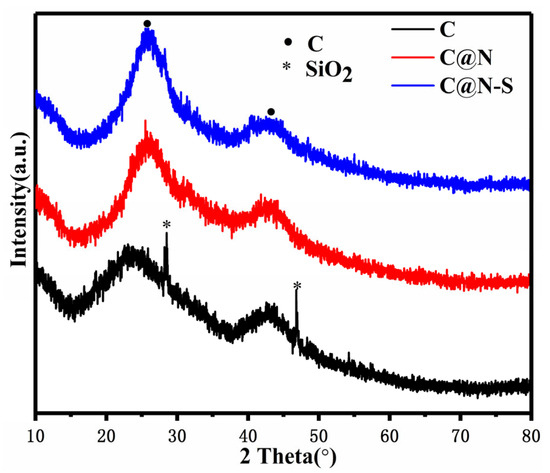
Figure 1.
XRD pattern of C carriers prepared by pomelo peel powder.
The microscopic morphology of the three carriers, C, C@N, and C@N-S, prepared using pomelo peel powder is shown in Figure 2. As can be seen from Figure 2a, the biomass carbon prepared from pomelo peel powder by the molten salt method is in the form of flakes without other visible impurities. The size of the carbon flakes is 1–10 μm and there are micropores distributed on the carbon flakes; this structure increases the specific surface area of the carbon flakes. Figure 2b,c show the biomass carbon generated by doping N and N-S elements, respectively. There is no obvious difference in morphology with the carbon flakes without adding other elements, which shows that pomelo peel powder can be prepared as pure carbon by the molten salt method and biomass carbon can be obtained without any other treatment.
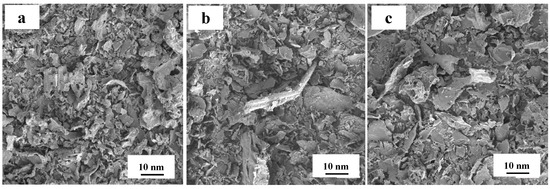
Figure 2.
SEM pattern (a) C, (b) C@N, and (c) C@N-S of carriers.
3.2. Elementally Doped WC/C Catalysts and Electrochemical Activities
Figure 3a shows the XRD analysis pattern of WC/C@N catalysts prepared by adding different masses of pomelo peel powder. It can be seen that the XRD diffraction peaks at 31.5°, 35.6°, 48.3°, 64.0°, 65.8°, 73.1°, 75°, and 77.1° correspond to (001), (100), (101), (110), (002), (111), (200), and (102), which corresponds to the WC (JCPDS 51-0939) standardized cards.
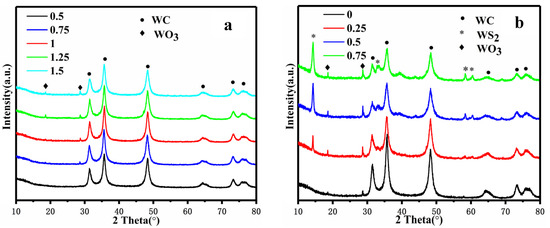
Figure 3.
XRD analysis profiles of (a) WC/C@N with the addition of different masses of grapefruit peel powder and (b) WC/C@N-S different L-cysteine additions.
In a material system where ammonium metatungstate ((NH4)6H2W12O40·xH2O) and a carbon source coexist, the thermal decomposition of ammonium metatungstate under the action of high temperature produces WO3, which subsequently reacts with C to form WC [21], presented as the following chemical reaction formula:
(NH4)6H2W12O40·xH2O → 12WO3 + 6NH3 + (x + 1)H2O
2WO3 + 2C → 2WC + 3O2
In this study, WC/C@N-S catalysts with different cysteine additions were selected to be prepared by adding 1 g of pomelo peel powder, and their XRD analysis profiles are shown in Figure 3b. It can be seen that the XRD diffraction peaks of the WC/C@N-S catalyst prepared by adding different amounts of cysteine were consistent with the corresponding WC of the WC/C@N catalyst, and a small amount of WS2 and WO3 was generated by the reaction. WS2 is the reaction product of WO3 with H2S produced by the thermal decomposition of L-cysteine (C3H7NO2S), represented by following chemical reaction:
2WO3 + 6C3H7NO2S → 2WS2 + S2 + 3C6H10N2O4 + 6H2O
There was a trace increase in the diffraction peaks of WS2 with the growth in elemental S addition. Zhang et al. [22] showed not only that WS2 possess good catalytic activity, but also that the WS2-WO3 heterostructure is favorable for electron transport and cell stability. Therefore, micro-modulation of the electron transport channel of WC/C@N-S catalysts by S-element doping strategy is expected to improve its HER performance.
The morphological observation, elemental distribution, and TEM analysis of the samples are shown in Figure 4 and Figure 5. Figure 4a,b show the SEM images of WC/C@N powder samples prepared from WC/C and pomelo peel powder for 1 g, respectively, and it can be seen that there is surface particle agglomeration on the unadded N-doped WC/C catalysts, while the surface particles of the WC/C@N are uniformly distributed on the carbon flakes in a monolayer single-particle distribution, and this microscopic morphology and structure are in line with the requirements of the distribution of catalytic particles for high-performance catalysts. This structure can significantly increase the specific surface area of the catalyst, promote electron transport and full contact between the catalytic particles and the active H, improve the performance of the catalyst, reduce the overpotential, and make the catalyst well stabilized to continuously generate hydrogen without poisoning. The elemental surface scans of C, W, and N are shown in Figure 5a–c, which show that C substrate is successfully doped with N in a uniform manner. It can be assumed that the N element inhibits the surface particle agglomeration during the penetration–diffusion process, thus improving the specific surface area and catalytic activity.
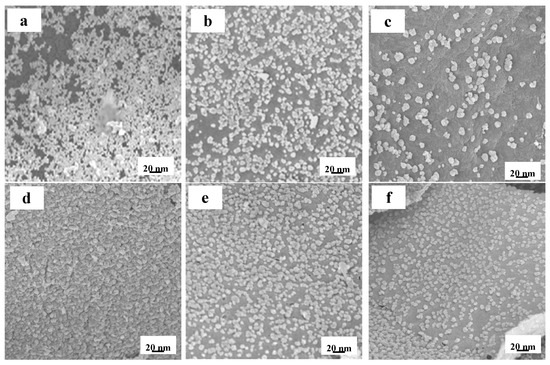
Figure 4.
SEM images of (a) undoped WC/C and (b–d) WC/C@N with 1 g, 0.5 g, and 1.5 g pomelo peel powder and (e,f) WC/C@N-S with 0.25 g and 0.5 g of cysteine.
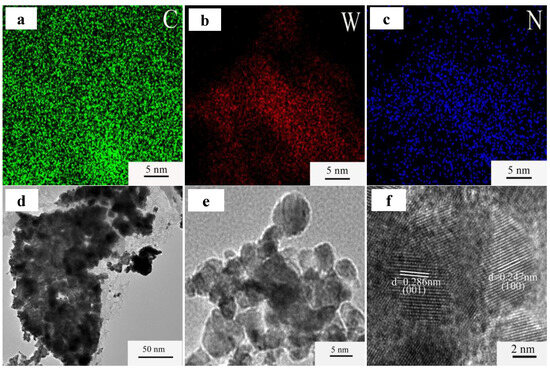
Figure 5.
SEM surface scan of (a) C, (b) W, and (c) N distribution, and (d,e) TEM analysis and (f) HRTEM analysis of WC/C@N sample.
In order to further confirm the physical phase of the particles on the surface of the carbon flake, the WC/C@N powder sample of Figure 5b was subjected to TEM analysis, as shown in Figure 5d–f. From Figure 5f, clear lattice stripes of nanocrystals can be observed, and the corresponding crystal plane spacing d is 0.247 nm and 0.286 nm, which corresponds to the (100) and (001) crystal planes of WC; it can be seen that the uniformly distributed particles on the surface of the carbon flake are the WC particles, which is in agreement with the results of XRD.
Figure 4c,d were WC/C@N powders prepared by adding 0.5 g and 1.5 g of pomelo peel powder, respectively. It can be seen that when 0.5 g of pomelo powder is added, the WC particles are sparse and the catalytic active site is obviously insufficient. With the increase in pomelo peel powder quality, the number of WC particles generated also increased, and the distribution state on the surface of the carbon sheet became more and more dense. When the calcination temperature exceeds 658 °C, the KCl/NaCl salt changes from the solid phase to the liquid phase. In this case, the KCl/NaCl molten salt promotes the dissolution and migration of tungsten, thereby accelerating the occurrence of carburizing reaction (2), so with the increase in pomelo peel powder, the carburizing reaction continues, and the WC particles gradually cover the entire carrier surface. However, excessive WC aggregated on the surface as well as accumulation and agglomeration reduced the specific surface area and exposed active sites, as shown in Figure 4d, which reduced the catalytic activity, which further verified that the optimal dosage of pomelo peel powder in this experiment was 1 g.
The SEM images of WC/C@N-S powder samples prepared by adding different amounts of cysteine (S source) on the basis of 1 g of pomelo peel powder were added, as shown in Figure 4e,f. It can be seen that the WC particles on the surface of the catalyst with different amounts of cysteine are still evenly distributed. WC forms particles that are dispersed on the surface of the carbon sheet, which exposes more active sites and contributes to the HER performance of WC. Moreover, the bonding state of WC particles with carbon sheet is improved, and the stability of the catalyst is enhanced.
Figure 6 shows the N2 adsorption–desorption isotherms of the WC/C@N-S and WC/C catalysts. The specific surface areas of the WC/C@N-S catalyst with 0.25 g cysteine and WC/C catalyst without N-S were 337.3 m2/g and 157.6 m2/g, respectively. The larger the specific surface area, the more surface active sites can be provided, and the HER activity of the catalyst will be increased. By comparing the specific surface areas of the two catalysts, it can be shown that N-S doping plays an important role in enhancing the catalytic performance of the WC/C catalysts.
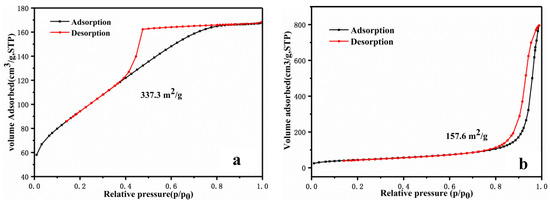
Figure 6.
N2 adsorption–desorption isotherm curves of (a) WC/C@N-S and (b) WC/C without N-S-doping.
The hydrogen evolution performance of water electrolysis was tested in 0.5 mol/L H2SO4 solution, and the results are shown in Figure 7. The HER performance of the WC/C@N-S catalyst was evaluated using the overpotential required to generate a 10 mA/cm2 cathode current density, and the iR-corrected LSV curve is shown in Figure 7a. The LSV curve records the current density as a function of potential at a certain scan rate. The lower the overpotential at a specific current density (e.g., 10 mA/cm2), the better the catalytic performance. The Tafel curve shown in Figure 7b is the logarithm of overpotential (η) to current density (lg|j|) plotted by the LSV curve. The relationship curve (η = a + blg |j|, where j is the current density and b is the Tafel slope) reflects the relationship between reaction rate and overpotential. The smaller the Tafel slope, the faster the charge transfer and H* desorption process, which is the key index to judge the electrocatalytic performance of the HER catalyst. There are usually two mechanisms of the HER: one is the Volmer mechanism (adsorption), that is, hydrogen ions (H+) adsorb and accept electrons on the surface of the catalyst to form adsorbed hydrogen atoms (H*); the second is the Heyrovsky mechanism (electrochemical desorption), which is the adsorption of hydrogen atoms (H*) combined with hydrogen ions in solution to produce hydrogen (H2). Different reaction mechanisms correspond to different rate controls, and when the reaction is the rate control of the Volmer mechanism, the Tafel slope is about 120 mV/dec. When the reaction is rate-controlled by the Heyrovsky mechanism, the Tafel slope is about 40 mV/dec [9,21]. If the Tafel slope is between the two, it can be judged that the Volmer and Heyrovsky mechanisms jointly control the reaction rate, that is, the Volmer–Heyrovsky kinetic process.
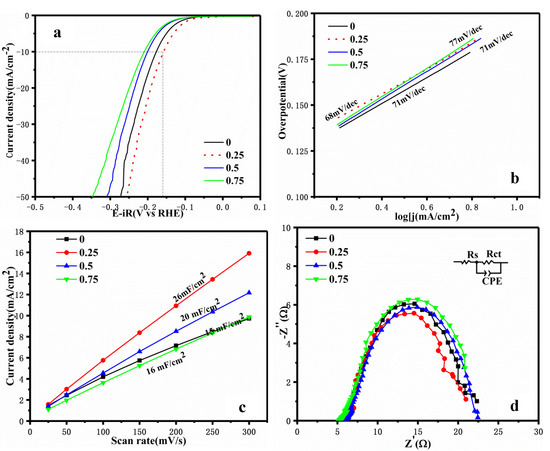
Figure 7.
(a) LSV curves, (b) Tafel curves, (c) fitted curve of scan rate versus cathode current density difference, and (d) impedance curves of WC/C@N-S with different cysteine.
As can be seen from Figure 7a,b, the overpotential of the WC/C@N-S catalyst with 0.25 g cysteine is 158 mV at 10 mA/cm2 and the Tafel slope is 68 mV/dec. The catalytic performance was better than that of the undoped WC/C catalyst and other WC/C@N-S catalysts with different cysteine addition. The Tafel slope value shows that the HER rate of all WC/C@N-S electrocatalysts in this study is determined by the co-effect of decomposition of H2O molecules (Volmer mechanism) and the desorption of bonded hydrogen atoms from the catalyst surface (Heyrovsky mechanism) [23,24], which is the Volmer–Heyrovsky kinetic process. Table 3 shows a comparison of the performance of the WC/C@N-S catalyst with 0.25 g cysteine in this study and other hydrogen evolution electrocatalysts in other studies. Obviously, the performance of WC/C@N-S catalysts remains competitive while ensuring low cost.

Table 3.
Comparison of WC/C@N-S catalyst and other electrocatalysts.
The electrochemical performance of the doped elements is significantly improved compared with the undoped WC/C, as shown in Figure 7a. The linear sweep voltammetry (LSV) curve of the catalyst with 0.25 g of cysteine was shifted to the right compared with the curve without (0 g) cysteine, the overpoints decreased, and the Tafel slope was reduced, as shown in Figure 7b. Due to the difference in electronegativity (N: 3.04; S: 2.58; C: 2.55), the doped N and S atoms make the positive charge density of the adjacent C atoms greater. These adjacent C atoms become new active sites, thereby increasing the catalytic activity of the catalyst [30]. In addition, due to the electron-withdrawing properties of N and S atoms [31,32], the N-S doped C matrix facilitates the extraction of electrons from WC. This charge transfer process alters the electronic structure of adjacent W and C atoms, thereby decreasing the d-band center of W, decreasing the W-H* binding strength, and increasing HER activity [33]. QU et al. [34] showed that N-S doping can not only change the electronic structure but also produce geometric structure defects. At lattice defects, the combination of a positively charged N-dopant and a negatively charged S-dopant provides a rapid electron transfer path for an HER [35]. Thus, the increased HER activity of the WC/C@N-S catalysts is a result of the combined effect of N-S doping and the geometrical lattice defects of the nanocarbon itself.
The effects of different cysteine additions on the HER activity of the WC/C@N-S catalyst are also compared in Figure 7, and it can be seen that the WC/C@N-S catalyst with 0.25 g of cysteine has the best HER activity, with the lowest corrosion ionization density (Figure 7a) and Tafel slope (Figure 7b). S doping causes lattice defects in the C matrix to overcome a certain energy barrier [34]. The S atoms that can participate in hybridization are limited, and excessive addition of cysteine reduces the hybridization rate of S, which in turn reduces the catalytic HER performance, so with the increase in cysteine addition, the capacitance value of the electric double layer decreases, and the impedance value increases, as shown in Figure 7c,d.
In order to investigate the effect of N-S doping on WC/C nanocatalysts, the valence state and structural composition of WC/C@N-S catalysts were analyzed by X-ray photoelectron spectroscopy (XPS). The full XPS spectrum (Figure 8a) shows that the catalyst has binding energy peaks for C, W, O, N, and S. In the high-resolution XPS spectrum of W4f, there are two pairs of peaks. The first pair of low binding energy peaks (32.5 eV for W4f7/2 and 34.8 eV for W4f5/2) can be attributed to WC. The high-resolution C1s spectra can fit consistent peaks concentrated at 284.8 eV, 285.6 eV, and 289.3 eV, attributed to C-C, C-N, and C=O, respectively. The high-resolution N1s spectra were fitted into four peaks, namely, pyridine N (399.1 eV), pyrrole N (400.5 eV), graphite N (401.4 eV), and oxide N (402.3 eV), and the high-resolution S2p spectrum was fitted into four peaks, corresponding to WS2 (162.3 eV), pyrrole S (163.5.5 eV), graphitic S (165.3 eV), and oxide S (168.3 eV), respectively. In the N1s and S2p spectra, peaks of graphite N and graphitic S were observed, indicating that the N and S atoms were successfully doped into the carbon atoms.
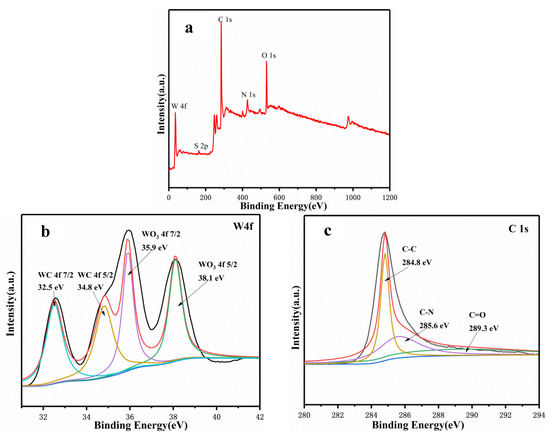
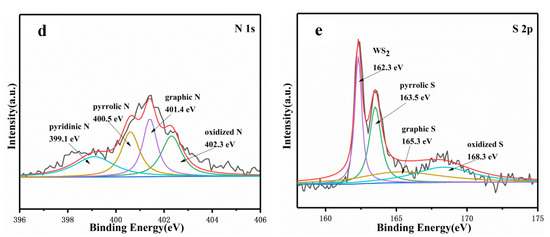
Figure 8.
(a) Full XPS spectra, (b) W 4f, (c) C 1s, (d) N 1s, and (e) S2p analytical mapping of WC/C@N-S catalysts.
Figure 9 shows the XPS spectrum without N-S doping, which shows that there are only three elements, W, C, and O, and the chemical bond is relatively simple. The W4f and C1s spectra show obvious changes in electronic structure compared with that of the N-S doped XPS spectrum, which further verifies that the intrinsic catalytic performance enhancement mechanism of WC/C-N-S catalysts by N-S doping is a result of a change in electronic structure due to coupled N-S doping. The N and S elements have higher electronegativity than with the C element, which makes adjacent C atoms exhibit higher positive charge density and become new active centers [36,37,38]. Due to the N-S doping of the C carrier, the electron density in the C carrier was increased, and the internal electronic structure of WC was adjusted, so the binding strength of WC-H* was reduced, which promoted the desorption of H* in the HER process [39] and thus improved the HER performance of WC/C@N-S catalysts.
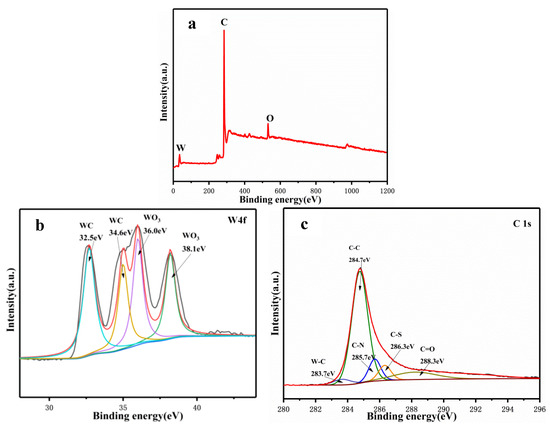
Figure 9.
(a) Full XPS spectra, (b) W 4f, and (c) C 1s analytical mapping of WC/C catalysts without N-S doping.
4. Conclusions
In order to solve the problems of high hydrogen energy catalyst manufacturing costs and serious waste of agricultural biomass resources, this paper used pomelo peel powder as the carbon source and AMT as the tungsten source to prepare biomass carbon-supported nano-WC catalysts by molten salt carbonization method, and explored the effect of N-S doping on hydrogen evolution performance in WC/C catalysts; the main conclusions are as follows:
- (1)
- The molten salt method can be used to successfully carbonize pomelo peel powder into flaked and pure biomass carbon with a good specific surface. The sheet structure of biomass carbon doped by N-S remains unchanged.
- (2)
- The N-S-doped WC/C@N-S catalyst, composed of WC, WS2, and WO3, inhibited the agglomeration of surface WC particles and increased the specific surface area from 157.6 m2/g to 337.2 m2/g, thereby improving the HER performance of the catalyst.
- (3)
- N-S doping improves the HER activity of WC/C@N-S catalysts by changing the electronic structure of WC and producing lattice defects, promoting electron transfer and increasing the specific surface area. The hydrogen evolution performance of the N-S-doped WC/C@N-S catalyst was evaluated in a 0.5 mol/L H2SO4 solution. The results showed that when the cathodic current density reached 10 mA/cm2, the overpotential was 158 mV and the Tafel slope was 68 mV/dec, indicating good electrochemical activity.
Author Contributions
Z.L.: Writing—original draft, Methodology, Investigation, Formal analysis, Data curation, Conceptualization. B.W. and S.L.: Writing—review and editing, Writing—original draft, Visualization, Data curation. F.P.: Writing—original draft, Visualization, Methodology, Data curation. X.Z. and X.W.: Supervision, Project administration, Funding acquisition. All authors have read and agreed to the published version of the manuscript.
Funding
This research and the APC was funded by the Key R&D Plan of Shaanxi Province grant number No. 2024NC-YBXM-229.
Institutional Review Board Statement
Not applicable.
Informed Consent Statement
Not applicable.
Data Availability Statement
Data will be made available on request.
Conflicts of Interest
The authors declare that they have no known competing financial interests or personal relationships that could have appeared to influence the work reported in this paper.
References
- Laimon, M.; Yusaf, T. Towards energy freedom: Exploring sustainable solutions for energy independence and self-sufficiency using integrated renewable energy-driven hydrogen system. Renew. Energy 2024, 222, 119948. [Google Scholar] [CrossRef]
- Zhang, G.Q.; Li, J.K.; Wang, Y.X.; Lei, L.F.; Zhuang, L.Z. Controlled Aggregation of Cobalt and Platinum Atoms via Plasma Treatment for Exceptional Hydrogen Evolution Reaction Activity. Coatings 2024, 14, 1569. [Google Scholar] [CrossRef]
- Kannaiyan, K.; Lekshmi, G.S.; Ramakrishna, S.; Kang, M.; Kumaravel, V. Perspectives for the green hydrogen energy-based economy. Energy 2023, 284, 129358. [Google Scholar] [CrossRef]
- Murugesan, R.; Yesupatham, M.S.; Agamendran, N.; Sekar, K.; Neethinathan, C.S.S.; Maruthapillai, A. Recent advances in biomass-derived carbon-based nanostructures for electrocatalytic reduction reactions: Properties-performance correlation. Energy Technol. 2024, 12, 882. [Google Scholar] [CrossRef]
- Sun, J.M.; Wu, Z.W.; Ma, C.H.; Xu, M.C.; Luo, S.; Li, W.; Liu, S.X. Biomass-derived tubular carbon materials: Progress in synthesis and applications. J. Mater. Chem. A 2021, 9, 13822–13850. [Google Scholar] [CrossRef]
- Li, L.; Lu, S.; Fang, L.; Wei, Y.J.; Yang, S.L. Review on Biomass-derived carbon-based materials for electrocatalytic hydrogen production: State of the art and outlook. Energy Fuels 2023, 37, 18485–18501. [Google Scholar] [CrossRef]
- Alorku, K.D.; Shen, C.; Li, Y.H.; Xu, Y.; Wang, C.G.; Liu, Q.Y. Biomass-derived 2-methyltetrahydrofuran platform: A focus on precious and non-precious metal-based catalysts for the biorefinery. Green Chem. 2022, 24, 4210–4236. [Google Scholar] [CrossRef]
- Zhang, M.M.; Li, P.F.; Wu, D.P. Synthesis and application of biomass-derived carbon-based nanomaterial. Nanomaterials 2023, 13, 2020. [Google Scholar] [CrossRef]
- Yan, P.P.; Wu, Y.C.; Wei, X.F.; Zhu, X.W.; Su, W. Preparation of robust hydrogen evolution reaction electrocatalyst WC/C by molten salt. Nanomaterials 2020, 10, 1621. [Google Scholar] [CrossRef]
- Xiao, J.J.; Chen, Q.F.; Yu, R.; Qian, J.Y.; Liu, Z.H.; Li, T.; Yang, H.P.; Shao, J.A.; Yang, W.R.; Chen, H.P. Enhanced stability of tungsten carbide catalysts via superhydrophobic modification for one-pot conversion of biomass-derived fructose involving water and iodine. Appl. Surf. Sci. 2021, 565, 150523. [Google Scholar] [CrossRef]
- Jiang, W.Y.; Gao, Z.H.; Shen, M.; Zhou, J.; Tang, R.; Zhang, L.J.; Wang, J.Q. Molten salt N-modified Mo2CTx as a non-precious metal catalyst for efficient hydrogen evolution reaction. Int. J. Hydrogen Energy 2024, 57, 1–7. [Google Scholar] [CrossRef]
- Eunsu, J.; Cho, J.W.; Kim, J.; Kim, J. WC nanoparticles and NiFe alloy co-encapsulated in N-doped carbon nanocage for exceptional OER and ORR bifunctional electrocatalysis. Appl. Surf. Sci. 2024, 663, 160201–160210. [Google Scholar] [CrossRef]
- Qu, K.G.; Chen, Z.F.; Wang, L.H.; Li, H.B.; Zeng, S.Y.; Li, R.; Meng, L.J.; Chen, H.Y.; Yao, Q.X. Covalent organic framework assisted low-content ultrafine Ru on porous N-doped carbon for efficient hydrogen evolution reaction. Rare Met. 2025, 44, 2094–2102. [Google Scholar] [CrossRef]
- Li, G.X.; Yu, J.Y.; Yu, W.Q.; Yang, L.J.; Zhang, X.L.; Liu, X.Y.; Liu, H.; Zhou, W.J. Phosphorus-doped iron nitride nanoparticles encapsulated by nitrogen-doped carbon nanosheets on iron foam in situ derived from saccharomycetes cerevisiae for electrocatalytic overall water splitting. Small 2020, 16, 2001980. [Google Scholar] [CrossRef]
- Jiang, Q.C.; Li, J.; Gao, J.Y.; Zhu, W.J.; Liu, H.H.; Yang, Y.J.; Ren, Y.J.; Lv, Y.R.; Wang, L.; He, Z.X. Marine biomass–derived nitrogen-doped carbon microsphere electrocatalyst for vanadium redox flow battery. Ionics 2023, 29, 259–269. [Google Scholar] [CrossRef]
- Wang, Y.H.; Li, R.Q.; Li, H.B.; Huang, H.L.; Guo, Z.J.; Chen, H.Y.; Zheng, Y.; Qu, K.G. Controlled synthesis of ultrasmall RuP2 particles on N, P-codoped carbon as superior pH-wide electrocatalyst for hydrogen evolution. Rare Met. 2021, 40, 1040–1047. [Google Scholar] [CrossRef]
- Zhao, G.Y.; Yu, D.F.; Zhang, H.; Sun, F.F.; Li, J.W.; Zhu, L.; Sun, L.; Yu, M.; Besenbacher, F.; Sun, Y. Sulphur-doped carbon nanosheets derived from biomass as high-performance anode materials for sodium-ion batteries. Nano Energy 2020, 67, 104219. [Google Scholar] [CrossRef]
- Levinas, R.; Tsyntsaru, N.; Cesiulis, H.; Viter, R.; Grundsteins, K.; Tamasauskaite-Tamasiunaite, L.; Norkus, E. Electrochemical Synthesis of a WO3/MoSx Heterostructured Bifunctional Catalyst for Efficient Overall Water Splitting. Coatings 2023, 13, 673. [Google Scholar] [CrossRef]
- Prasert, K.; Sanglaow, T.; Liangruksa, M.; Sutthibutpong, T. Effects of stacking layers and different doping elements on the electronic structures and quantum capacitance of graphene: A DFT study. J. Phys. Chem. Solids 2024, 185, 111758. [Google Scholar] [CrossRef]
- Wu, H.Y.; Zhao, Q.Q.; Jiang, S.; Liu, W.; Xiao, H.N.; Wu, W.B. Research advances in doped carbon electrocatalysts derived from biomass. Chem. Eng. J. 2025, 505, 159694. [Google Scholar] [CrossRef]
- Su, W.; Yan, P.P.; Wei, X.F.; Zhu, X.W.; Zhou, Q.Y. Facile one-step synthesis of nitrogen-doped carbon sheets supported tungsten carbide nanoparticles electrocatalyst for hydrogen evolution reaction. Int. J. Hydrogen Energy 2020, 45, 33430–33439. [Google Scholar] [CrossRef]
- Zhang, B.; Luo, C.; Deng, Y.Q.; Huang, Z.J.; Zhou, G.M.; Lv, W.; He, Y.B.; Wan, Y.; Kang, F.Y.; Yang, Q.H. Optimized catalytic WS2-WO3 heterostructure design for accelerated polysulfide conversion in lithium-sulfur batteries. Adv. Energy Mater. 2020, 10, 2000091. [Google Scholar] [CrossRef]
- Hussain, S.; Akbar, K.; Vikraman, D.; Afzal, R.A.; Song, W.; An, K.S.; Farooq, A.; Park, J.Y.; Chun, S.H.; Jung, J. WS(1-x)Sex nanoparticles decorated three-dimensional graphene on nickel foam: A robust and highly efficient electrocatalyst for the hydrogen evolution reaction. Nanomaterials 2018, 8, 929. [Google Scholar] [CrossRef] [PubMed]
- Hussain, S.; Chae, J.; Akbar, K.; Vikraman, D.; Linh, L.; Naqvi, B.A.; Abbas, Y.; Kim, H.S.; Chun, S.H.; Kim, G.; et al. Fabrication of robust hydrogen evolution reaction electrocatalyst using Ag2Se by vacuum evaporation. Nanomaterials 2019, 9, 1460. [Google Scholar] [CrossRef]
- Zeng, M.Q.; Luo, R.; Deng, X.Y.; Song, Y.L.; Hao, W.J.; Fan, J.C.; Bi, Q.Y.; Li, G.S. Molten-salt-chemistry-assisted synthesis of layered N-doped tungsten carbide with enhanced electrical conductivity for efffcient electrocatalytic hydrogen evolution. Int. J. Hydrogen Energy 2024, 92, 1021–1029. [Google Scholar] [CrossRef]
- Nguyen, T.V.; Do, H.H.; Tekalgne, M.; Le, Q.V.; Nguyen, T.P.; Hong, S.H.; Cho, J.H.; Dao, D.V.; Ahn, S.H.; Kim, S.Y. WS2-WC-WO3 nano-hollow spheres as an efficient and durable catalyst for hydrogen evolution reaction. Nano Converg. 2021, 8, 28. [Google Scholar] [CrossRef]
- Nguyen, T.V.; Nguyen, T.P.; Le, Q.V.; Dao, D.V.; Ahn, S.H.; Kim, S.Y. Facile route for synthesizing WS2/W2C nano hollow flowers and their application for hydrogen evolution reaction. J. Alloys Compd. 2023, 955, 170231. [Google Scholar] [CrossRef]
- Wang, Y.N.; Zhang, L.P.; Meng, X.X.; Feng, L.; Wang, T.; Zhang, W.M.; Yang, N.T. Scalable processing hollow tungsten carbide spherical superstructure as an enhanced electrocatalyst for hydrogen evolution reaction over a wide pH range. Electrochim. Acta 2019, 319, 775–782. [Google Scholar] [CrossRef]
- Wei, X.D.; Li, N. Tungsten carbide/carbon composites coated with little platinum nano particles derived from the redox reaction between in-situ synthesized WC1-x and chloroplatinic acid as the electrocatalyst for hydrogen evolution reaction. Appl. Surf. Sci. 2019, 463, 1154–1160. [Google Scholar] [CrossRef]
- Zhu, J.; Hu, L.S.; Zhao, P.X.; Lee, L.Y.S.; Wong, K.Y. Recent advances in electrocatalytic hydrogen evolution using nanoparticles. Chem. Rev. 2020, 120, 851–918. [Google Scholar] [CrossRef]
- Lin, L.X.; Sherrell, P.; Liu, Y.Q.; Lei, W.; Zhang, S.W.; Zhang, H.J.; Wallace, G.G.; Chen, J. Engineered 2D transition metal dichalcogenides—A vision of viable hydrogen evolution reaction catalysis. Adv. Energy Mater. 2020, 10, 1903870. [Google Scholar] [CrossRef]
- Liu, Y.P.; Yu, G.T.; Li, G.D.; Sun, Y.H.; Asefa, T.; Chen, W.; Zou, X.X. Coupling Mo2C with nitrogen-rich nanocarbon leads to efficient hydrogen-evolution electrocatalytic sites. Angew. Chem. Int. Ed. 2015, 127, 10752–10757. [Google Scholar] [CrossRef] [PubMed]
- Xu, Y.T.; Xiao, X.F.; Ye, Z.M.; Zhao, S.L.; Shen, R.A.; He, C.T.; Zhang, J.P.; Li, Y.D.; Chen, X.M. Cage-confinement pyrolysis route to ultrasmall tungsten carbide nanoparticles for efficient electrocatalytic hydrogen evolution. J. Am. Chem. Soc. 2017, 139, 5285–5288. [Google Scholar] [CrossRef]
- Qu, K.G.; Zheng, Y.; Da, S.; Qiao, S.Z. Graphene oxide-polydopamine derived N, S-codoped carbon nanosheets as superior bifunctional electrocatalysts for oxygen reduction and evolution. Nano Energy 2016, 19, 373–381. [Google Scholar] [CrossRef]
- Ito, Y.; Cong, W.T.; Fujita, T.; Tang, Z.; Chen, M.W. High Catalytic Activity of Nitrogen and Sulfur Co-Doped Nanoporous Graphene in the Hydrogen Evolution Reaction. Angew. Chem. Int. Ed. 2015, 54, 2131–2136. [Google Scholar] [CrossRef]
- Deng, J.; Ren, P.J.; Deng, D.H.; Bao, X.H. Enhanced electron penetration through an ultrathin graphene layer for highly efficien catalysis of the hydrogen evolution reaction. Angew. Chem. Int. Ed. 2015, 54, 2100–2104. [Google Scholar] [CrossRef]
- Liu, Y.P.; Li, G.D.; Yuan, L.; Ge, L.; Ding, H.; Wang, D.J.; Zou, X.X. Carbon-protected bimetallic carbide nanoparticles for a highly efficient alkaline hydrogen evolution reaction. Nanoscale 2015, 7, 3130–3136. [Google Scholar] [CrossRef]
- Zou, X.X.; Huang, X.X.; Goswami, A.; Silva, R.; Sathe, B.R.; Mikmeková, E.; Asefa, T. Cobalt-embedded nitrogen-rich carbon nanotubes efficiently catalyze hydrogen evolution reaction at all pH values. Angew. Chem. Int. Ed. 2014, 53, 4372–4376. [Google Scholar] [CrossRef]
- Wang, S.P.; Wang, J.; Zhu, M.L.; Bao, X.B.; Xiao, B.Y.; Su, D.F.; Li, H.R.; Wang, Y. Molybdenum carbide modified nitrogen-doped carbon vesicle encapsulating nickel nano-particles: A highly efficient, low-cost catalyst for hydrogen evolution reaction. J. Am. Chem. Soc. 2015, 137, 15753–15759. [Google Scholar] [CrossRef]
Disclaimer/Publisher’s Note: The statements, opinions and data contained in all publications are solely those of the individual author(s) and contributor(s) and not of MDPI and/or the editor(s). MDPI and/or the editor(s) disclaim responsibility for any injury to people or property resulting from any ideas, methods, instructions or products referred to in the content. |
© 2025 by the authors. Licensee MDPI, Basel, Switzerland. This article is an open access article distributed under the terms and conditions of the Creative Commons Attribution (CC BY) license (https://creativecommons.org/licenses/by/4.0/).